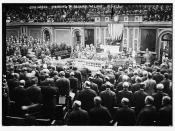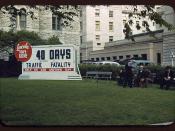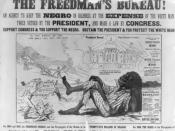The Civil War was not a struggle between classes, but a sectional fight having its roots in political, economic, and social elements so confusing that people still do not agree on its causes. "It has been characterized, in the words of William H. Seward, as the "irrepressible conflict."." Both views accept the fact that in 1861 there existed a situation that had come to be regarded as insoluble by peaceful means. The two main causes of the Civil war were the election of 1860 and South Carolina secedding from the union Reconstruction, also known as Radical Reconstruction, was the period after the American Civil War. During this time the South was in political, social, and economic turmoil, and eleven Confederate states had seceded. In response, the Union attempted to regain order in the Confederate states by any means possible.
In the days of the American Revolution and of the adoption of the Constitution, differences between North and South were shortened by their common interest in establishing a new nation.
But sectionalism steadily grew stronger. During the 19th century the South remained almost completely agricultural, with an economy and a social order largely founded on slavery and the plantation system. These mutually dependent institutions produced the staples, especially cotton, from which the South derived its wealth. The North had its own great agricultural resources, was always more advanced commercially, and was also expanding industrially.
Hostility between the two sections grew noticeable after 1820, the year of the Missouri Compromise, which was intended as a permanent solution to the issue in which that hostility was most clearly expressed--the question of the extension or prohibition of slavery in the federal territories of the West. Difficulties over the tariff (which led John C. Calhoun and South Carolina to nullification and to an extreme states'...


